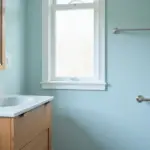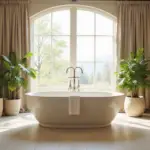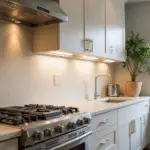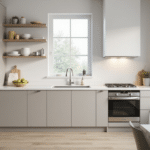The bedroom should be your sanctuary—a place where you can escape the chaos of daily life and truly unwind. If you’re dreaming of a space that radiates tranquility, beige might be your perfect ally. Often dismissed as boring, beige is actually a sophisticated chameleon capable of creating deeply peaceful environments with remarkable versatility.
The beauty of beige bedroom ideas lies in their ability to adapt. From warm sand tones that evoke Mediterranean beaches to cool, sophisticated taupes that whisper of luxury, beige offers a spectrum of possibilities. When layered with textures and complemented with thoughtful accents, a beige bedroom becomes anything but ordinary—it transforms into a haven of serenity that speaks to both your aesthetic sensibilities and your need for rest.
1. The Power of Beige Walls: A Calming Canvas
The walls of your bedroom establish the foundation for your sanctuary, and beige provides an exceptional starting point. Beige walls possess inherent qualities that foster tranquility—they don’t overwhelm the senses but instead create a grounding backdrop that allows the mind to decompress. Their connection to earth and sand evokes natural serenity, while their light-reflecting properties make spaces feel more open and airy.

The spectrum of beige offers remarkable variety. Warmer beiges with yellow or orange undertones create cozy, inviting spaces—perfect for bedrooms that need to feel like a gentle embrace. Cooler beiges with gray or green undertones deliver a more contemporary sophistication, creating an airy, spacious feeling even in smaller rooms. The key lies in testing samples at different times of day to observe how natural and artificial light transform the color.
The magic of beige walls begins when you consider them not as a default choice, but as the first intentional step in crafting your personal retreat. Running your hand across this material reveals how beige serves as nature’s neutral—a color that has surrounded humans in natural materials since the beginning of time.
2. Layering Beige Bedding for Ultimate Comfort
A well-layered bed creates both visual interest and practical comfort, especially in a beige bedroom. Layering different textures and tones prevents monotony while creating a bed that adapts to seasonal changes and temperature fluctuations throughout the night. The subtle variations in beige—from warm ivory to rich taupe—create a sophisticated depth that feels both luxurious and inviting.

The essential layers for a beige bed include:
- A high-quality fitted sheet in a soft beige tone
- A flat sheet in a complementary shade
- A lightweight quilt or blanket with subtle texture
- A plush duvet or comforter in a contrasting beige
- Pillows in varying sizes and textures
- A textured throw draped casually at the foot
What makes this design special is the way these layers interact with light and shadow throughout the day. Morning sunlight might highlight the nubby texture of a knit throw, while evening lamplight brings out the subtle sheen of sateen pillowcases. This interplay creates a bed that feels alive and inviting rather than flat and lifeless.
3. Incorporating Different Beige Textures
In a beige bedroom, texture becomes the unsung hero that prevents the space from feeling one-dimensional. Without varied textures, beige can indeed fall flat—but when you introduce contrasting tactile elements, the room gains depth, character, and visual interest that keeps it from feeling sterile or boring. Each texture creates its own relationship with light, casting subtle shadows and creating dimension.

Consider mixing chunky knit throws with smooth linen bedding, rough jute rugs with polished wooden furniture, matte walls with glossy ceramic lamps, or woven baskets with velvet pillows. The contrast between rough and smooth, matte and shiny, creates a rich sensory experience that engages both the eye and hand. These textures don’t just look different—they feel different, creating a multi-sensory environment that feels thoughtfully curated.
Unlike mass-produced alternatives, this technique allows your beige bedroom to develop a character all its own—one that reflects your personal aesthetic while maintaining the calming qualities that drew you to beige in the first place.
4. Classic Combo: Beige and Crisp White
The pairing of beige and crisp white creates a timeless combination that feels both fresh and grounded. This duo works so harmoniously because white adds brightness and definition to beige’s warmth, preventing it from feeling muddy or undefined. The contrast is subtle enough to maintain tranquility while providing just enough visual interest to keep the space from feeling flat.

To create visual interest with this palette, focus on layering different materials and textures. Consider crisp white linens against a plush beige headboard, white-painted furniture with beige upholstery, or white trim against beige walls. Introduce subtle patterns like a white-on-beige jacquard fabric or a beige-on-white geometric rug. The key is maintaining balance—neither color should overwhelm the other.
The unexpected environmental benefit comes from this palette’s timelessness. Unlike trendy color schemes that might feel dated in a few years, beige and white create a foundation that remains relevant, reducing the urge to redecorate frequently—a more sustainable approach to bedroom design.
5. Modern Edge: Beige Paired with Charcoal Gray
The inspiration for this collection struck when designers began recognizing that beige bedrooms could be contemporary as well as calming. Pairing beige with charcoal gray creates a sophisticated balance that feels decidedly modern while maintaining serenity. The depth of charcoal provides visual weight and definition that prevents beige from feeling wishy-washy, while beige softens charcoal’s potential starkness.

To incorporate charcoal without overwhelming your beige bedroom, consider using it strategically in key areas. A charcoal accent wall behind the bed creates a dramatic focal point, while charcoal bedding against beige walls offers contrast without permanence. Smaller accents like charcoal picture frames, lampshades, or decorative objects add definition without commitment. The beauty of this combination lies in its flexibility—you can easily adjust the balance to suit your preference.
For those worried about maintenance, charcoal gray actually hides dust and small marks better than either very light or very dark colors, making it a practical choice for bedroom elements that see regular use.
6. Adding Drama with Black Accents
After months of sourcing and curation, designers have embraced the striking contrast black accents bring to beige bedrooms. This bold pairing creates definition and sophistication that elevates the entire space. Black provides the perfect counterpoint to beige’s softness, creating focal points that draw the eye and prevent the room from feeling bland or undefined.

To incorporate black effectively, think of it as punctuation in your design—use it sparingly but purposefully. Consider a black metal bed frame against beige walls, black picture frames displaying serene artwork, black lampshades atop beige ceramic bases, or black hardware on beige furniture. The contrast should feel intentional rather than jarring. For a more subtle approach, look for black accents with texture or pattern that soften their visual impact.
When clients ask us about balancing style with comfort, we often suggest starting with just a few black elements and observing how they affect the room’s feel before adding more. This measured approach ensures your beige bedroom maintains its calming essence while gaining definition and character.
7. Warmth of Wood Furniture in a Beige Room
The artisans behind these designs began with a simple observation: wood and beige are natural companions. Wood furniture brings warmth, texture, and organic beauty to a beige bedroom, preventing it from feeling sterile or flat. The natural grain patterns and rich tones of wood create subtle contrast against beige backgrounds, adding depth and character while maintaining the room’s serene quality.

Different wood tones create different effects in a beige bedroom. Warm woods like walnut, cherry, and oak complement beige beautifully, adding richness and preventing the space from feeling washed out. Lighter woods like maple or ash create a more Scandinavian-inspired look that feels bright and airy. The key is considering the undertones—warmer beiges pair naturally with warmer woods, while cooler beiges harmonize with more neutral or ashy wood tones.
The craftsmanship reveals itself in details like visible grain patterns, dovetail joints, or hand-finished surfaces. These elements add authenticity and character to your beige bedroom that mass-produced pieces often lack, creating a space that feels genuinely yours.
8. The Statement Upholstered Beige Headboard
The environmental story behind this piece began with a desire to create a focal point that doesn’t sacrifice serenity. An upholstered beige headboard serves as both a comfort-enhancing feature and a sophisticated design element. The softness of upholstery adds literal and visual comfort, creating an inviting backdrop for your bed while maintaining the calming neutral palette.

The versatility of a beige upholstered headboard makes it compatible with virtually any design style. In minimalist or contemporary bedrooms, a clean-lined beige headboard with minimal tufting creates elegant simplicity. In more traditional spaces, a shaped headboard with deeper button tufting adds classic luxury. Even bohemian-inspired bedrooms benefit from a beige headboard, which provides a neutral foundation for more eclectic bedding and accessories.
The finishing touch that elevates the entire look often comes from the fabric choice itself. Consider options like Belgian linen for casual elegance, plush velvet for luxurious comfort, or performance fabrics for practical durability. Each brings its own character while maintaining the soothing beige palette that defines your sanctuary.
9. Grounding the Room with a Beige Area Rug
The sustainable journey of this material involves recognizing how a beige area rug anchors your bedroom both visually and physically. A well-chosen rug creates a foundation that defines the bed area, adds warmth underfoot, and introduces essential texture. In a beige bedroom, a beige rug reinforces the serene palette while preventing monotony through subtle variations in tone and texture.

When selecting a beige rug, size matters significantly. For queen or king beds, choose a rug large enough to extend at least 18-24 inches beyond the sides and foot of the bed—typically 8’x10′ or 9’x12′. This allows you to step onto something soft when getting out of bed. For smaller rooms or twin beds, a 5’x8′ rug can work well. Consider leaving 12-18 inches of floor visible around the perimeter for a balanced look.
Beyond aesthetics, the tactile experience changes the entire room’s energy when you incorporate different rug materials. Wool offers durability and natural stain resistance, cotton provides affordability and washability, while jute or sisal brings organic texture and casual charm. Each material creates a different sensory experience that contributes to your bedroom’s overall feel.
10. Softening Light with Beige Curtains
As morning light filters through, the texture creates a gentle diffusion that transforms harsh sunlight into a soft, ambient glow. Beige curtains excel at this light-softening magic, creating a warm, welcoming atmosphere while maintaining the room’s neutral palette. They filter brightness without blocking it completely, allowing natural light to enhance the space without overwhelming it.

The fabric choice significantly impacts both the aesthetic and functional aspects of your beige curtains. Sheer or semi-sheer beige fabrics create a dreamy, ethereal quality as light passes through them, casting a warm glow throughout the room. Linen beige curtains offer similar light diffusion with added texture that creates subtle shadow play. For greater light control and privacy, lined cotton or blend curtains in beige provide versatility while maintaining the serene color scheme.
The maker’s journey from apprentice to master influenced the understanding that window treatments aren’t just decorative—they actively shape how we experience a space throughout the day. Consider how your bedroom’s orientation affects light quality and choose your beige curtains accordingly to create the perfect balance of illumination and serenity.
11. Pops of Color: How to Introduce Accents
While trendy, this element has staying power because even the most devoted beige enthusiast recognizes the power of thoughtful color accents. Strategic pops of color prevent a beige bedroom from feeling flat or impersonal, injecting energy and character while maintaining the overall tranquility. These accents create focal points and visual interest that make the space feel intentionally designed rather than simply neutral.

The colors that work best in a beige bedroom depend on both the specific shade of beige and your personal preference. Consider these popular options:
- Terracotta, rust, and burnt orange for a warm, earthy vibe
- Sage, olive, or emerald green for a nature-inspired feel
- Navy, teal, or dusty blue for sophisticated contrast
- Blush, mauve, or plum for soft, romantic warmth
- Mustard, ochre, or amber for golden warmth
The placement of these color accents matters as much as the colors themselves. Focus on easily changeable elements like throw pillows, blankets, artwork, or small decorative objects. This allows you to refresh the look seasonally or as your preferences evolve without major investment.
The designer’s secret here is to limit your accent palette to 2-3 complementary colors for a cohesive look. This prevents the space from becoming chaotic and preserves the calming foundation that makes beige bedroom ideas so appealing in the first place.
12. Sparkle and Shine: Metallic Touches
The revival of this classic form comes with a twist as metallic accents add luminosity and refinement to beige bedrooms. Gold, silver, brass, or copper elements introduce a subtle gleam that catches the light, creating dimension and preventing beige from feeling flat. These metallic touches add a touch of luxury without overwhelming the space’s serene quality.

Effective metallic accents include bedside lamps with metallic bases, picture frames, decorative objects, hardware on furniture pieces, or even a statement mirror with a metallic frame. The key is choosing metals that complement your specific shade of beige—warmer beiges pair beautifully with gold, brass, and copper, while cooler beiges harmonize with silver, chrome, and brushed nickel. The finish matters too; polished metals create more drama, while brushed or matte finishes offer subtler sophistication.
The cultural heritage preserved in each piece includes ancient traditions of metalworking that have symbolized luxury for millennia. From Egyptian gold to Roman silver, metallic elements have long represented refinement and status—a tradition that continues in today’s beige bedroom ideas with a contemporary twist.
13. Bringing Nature In: Rattan and Wood with Beige
The discovery of this technique happened when designers recognized that natural materials enhance the inherent serenity of beige bedrooms. Rattan and wood bring organic warmth and texture that perfectly complement the neutral backdrop, creating a grounded connection to the natural world. This pairing feels both timeless and contemporary, with natural materials adding authenticity and character to the calming beige palette.

Effective ways to incorporate these elements include rattan headboards or bed frames, wooden nightstands or dressers, woven baskets for storage, wooden picture frames, or rattan pendant lights. The key is choosing pieces with visible texture and grain that add visual interest to the neutral space. Consider mixing different woods and natural materials for a collected, organic feel rather than a matched set.
If you’ve struggled with similar rooms before, the solution often lies in these natural elements that prevent beige from feeling sterile or impersonal. The warmth and character of rattan and wood create an inviting atmosphere that feels both sophisticated and comfortable—the perfect balance for a bedroom retreat.
14. Achieving a Serene, Minimalist Beige Look
The silhouette draws inspiration from Japanese and Scandinavian design philosophies, where simplicity creates tranquility. A minimalist beige bedroom focuses on quality over quantity, embracing clean lines, uncluttered surfaces, and a sense of intentional restraint. This approach creates a deeply peaceful environment where every element serves both functional and aesthetic purposes.

The key elements of a minimalist beige bedroom include:
- A neutral color palette with subtle variations in beige tones
- Clean-lined furniture with minimal ornamentation
- Ample negative space that allows the room to “breathe”
- Carefully selected, meaningful accessories rather than numerous decorative items
- Quality natural materials that add subtle texture
- Functional storage solutions that keep clutter hidden
- Simple window treatments that maximize natural light
To prevent a minimalist beige bedroom from feeling bland, focus on incorporating varied textures and subtle tonal variations. A chunky knit throw against smooth linen bedding, a rough ceramic vase on a polished wooden surface, or a woven basket beside a sleek lamp—these textural contrasts create visual interest without cluttering the space.
The challenge of awkward spaces becomes easier when you embrace minimalism’s “less is more” philosophy, allowing the serene beige palette to create a sense of spaciousness and calm that more complex designs might not achieve.
15. Creating a Cozy, Hygge-Inspired Beige Retreat
Many homeowners wonder how to create a space that feels both stylish and deeply comfortable. Hygge (pronounced “hoo-ga”), the Danish concept of coziness and contentment, offers the perfect framework for a beige bedroom that prioritizes warmth, comfort, and well-being. This approach celebrates simple pleasures and creates a sanctuary from the outside world.

Essential elements of a Hygge-inspired beige bedroom include:
- Layers of soft textiles like chunky knit blankets, plush pillows, and soft rugs
- Warm, gentle lighting from table lamps, string lights, or candles
- Natural materials that connect to the outdoors
- Comfortable, inviting furniture that encourages relaxation
- Personal touches that evoke happy memories
- A clutter-free environment that focuses on what brings joy
“Hygge is about an atmosphere and an experience, rather than about things. It’s about being with the people we love. A feeling of home. A feeling that we are safe.” – Meik Wiking, The Little Book of Hygge
To prevent a Hygge-inspired beige bedroom from feeling monotonous, incorporate subtle variations in tone and plenty of texture. Mix creams, oatmeals, and taupes rather than using a single shade of beige. Add visual interest through textured wallpaper, a chunky knit throw, or a woven headboard. The goal is creating depth through texture rather than bold color contrasts.
The unexpected pairing that always works is combining ultra-soft textures with natural, rougher elements—think a sheepskin rug atop a jute carpet, or a chunky knit throw against linen bedding. This balance of textures creates a space that feels both refined and deeply comfortable.
16. Elevating the Space with Elegant Beige Details
The artisan collective that creates these pieces understands that beige’s sophistication lies in the details. Elegant beige bedrooms focus on refinement, quality materials, and thoughtful touches that elevate the neutral palette from basic to luxurious. These spaces feel curated rather than generic, with a timeless quality that transcends trends.

Key elegant details to consider include:
- High-quality bedding in natural fibers like Egyptian cotton, linen, or silk
- Subtle architectural elements like crown molding or wainscoting
- Well-proportioned furniture with refined lines
- Strategic metallics in hardware, lighting, or accessories
- Thoughtfully placed artwork with sophisticated framing
- Luxurious window treatments with proper fullness and length
- Carefully selected lighting that creates a warm glow
- Subtle patterns like tone-on-tone damask or small-scale geometrics
The visual weight balances perfectly when you pair these refined elements with the understated elegance of beige. The key is quality over quantity—fewer, better pieces create more impact than numerous lesser items. Consider investing in one standout element, like a beautifully upholstered headboard or an antique dresser, to serve as the room’s anchor.
While designed for the living room, we’ve seen creative uses in bedrooms of techniques like layering different beige tones to create depth and dimension. Consider a slightly darker beige on the lower portion of walls with a lighter shade above, or use subtle texture on one wall while keeping others smooth.
17. A Splash of Color: Beige and Navy Blue
The third-generation workshop where this comes to life specializes in the timeless pairing of beige and navy blue. This classic combination creates a sophisticated balance that feels both grounded and refined. The depth of navy provides beautiful contrast to beige’s lightness, creating visual interest while maintaining an overall sense of calm.

Effective ways to incorporate navy blue include:
- A navy blue upholstered headboard against beige walls
- Navy blue bedding with beige accents
- A navy blue accent wall behind the bed
- Navy blue curtains framing beige walls
- Navy blue throw pillows or blankets on a beige bed
- A navy blue bench or chair in a beige room
- Navy blue artwork in beige frames
- A navy blue rug anchoring a beige space
The composition comes together when you balance the proportions of each color. Generally, beige should remain dominant (covering 60-70% of the space) with navy as a supporting player (30-40%). This maintains the serene quality of the beige bedroom ideas while allowing the navy to create definition and interest.
For those hesitant about bold patterns, navy blue offers a safer way to introduce contrast without overwhelming the space. Its classic nature means it won’t quickly date, making it a smart investment for beige bedroom ideas that stand the test of time.
18. Gentle Harmony: Beige and Blush Pink
The collaboration began with a conversation about creating softness within neutrality. Beige and blush pink together create a gentle, romantic atmosphere that feels both sophisticated and inviting. The subtle warmth of blush pink adds dimension to beige without overwhelming its calming properties, resulting in a space that feels nurturing and refined.

This color combination works particularly well in bedrooms because it creates a sense of gentle embrace. Blush pink can be incorporated through bedding, throw pillows, artwork, a single accent wall, curtains, or decorative accessories. The key is choosing the right shade of blush—look for muted, dusty pinks rather than vibrant or candy-colored ones to maintain the sophisticated feel.
When your existing decor doesn’t seem to coordinate, consider the undertones of your beige elements. Beiges with warm, yellow undertones pair beautifully with peachy-pink blushes, while beiges with cooler, gray undertones harmonize with more mauve-leaning blush tones. This attention to undertones ensures a cohesive look that feels intentional rather than mismatched.
19. Living Green: Plants in a Beige Bedroom
The materials are sourced from a remarkable region where plants naturally thrive alongside neutral earth tones. Incorporating plants into a beige bedroom adds life, color, and improved air quality. The natural green of foliage creates beautiful contrast against the neutral backdrop while maintaining the room’s serene quality, connecting the space to nature in a way that feels both refreshing and calming.

Excellent plant choices for beige bedrooms include:
- Snake Plants: Upright, architectural, and extremely low-maintenance
- Pothos: Trailing vines that add movement and can be grown in hanging planters
- ZZ Plants: Glossy, dark green leaves that thrive in low light
- Peace Lilies: Elegant white flowers and air-purifying qualities
- Rubber Plants: Bold, burgundy-green leaves that make a statement
- Spider Plants: Arching, variegated foliage that’s nearly indestructible
When selecting planters, consider options that complement your beige palette. Terracotta pots add warmth and earthy texture, white ceramic creates clean contrast, while woven baskets add natural texture. Metal planters in brass or copper can introduce a touch of sophistication.
The mood shifts dramatically when you add even a few plants to a beige bedroom. Beyond their aesthetic value, plants have been shown to reduce stress, improve air quality, and even enhance sleep—making them perfect partners for creating a truly restful beige sanctuary.
20. The Subtle Impact of a Beige Accent Wall
The design language evolved from traditional patterns that once relied on bold colors for accent walls. A beige accent wall offers a more nuanced approach—creating subtle definition without disrupting the room’s tranquility. While an entirely beige room feels cohesive, a beige accent wall in a slightly different shade adds architectural interest and prevents the space from feeling flat.

The benefits of using beige for an accent wall are numerous. It maintains the calming atmosphere while adding depth and dimension. It’s less likely to tire quickly than a bold color. It creates a sophisticated backdrop for artwork or a bed. It’s easier to change if you decide to redecorate. And it works with virtually any style, from traditional to contemporary.
The styling mistake most people make is choosing beige shades that are too similar. For impact, select an accent color that’s at least two shades darker or lighter than your main beige. Consider adding texture through grasscloth wallpaper, subtle patterns, or techniques like color washing to enhance the distinction without relying solely on color difference.
21. Playing with Various Shades of Beige
The forecast for next season already hints at the sophisticated potential of layering different beige tones. This approach creates depth and visual interest while maintaining a cohesive, calming palette. The subtle variations prevent the room from feeling flat or monotonous without introducing contrasting colors that might disrupt the serene atmosphere.

Consider exploring these beige families:
- Warm beiges: Cream, sand, tan, camel, and cognac
- Cool beiges: Greige, taupe, mushroom, and stone
- Pink-toned beiges: Blush beige, champagne, and pale terracotta
- Yellow-toned beiges: Wheat, honey, and camel
The layering technique becomes most effective when combined with varying textures. A smooth satin pillow in warm sand against a nubby linen headboard in cool greige creates subtle contrast that adds dimension. A plush velvet throw in camel atop crisp cotton sheets in cream introduces depth through both color and texture.
The emotional response this evokes begins with a sense of harmony and subtle sophistication. Unlike high-contrast schemes that can feel energizing, layered beige bedroom ideas create a gentle visual rhythm that feels both refined and deeply restful—perfect for a space dedicated to relaxation and renewal.
22. The Right Lighting for a Beige Ambiance
Imagine coming home to the gentle glow of perfectly calibrated lighting that transforms your beige bedroom from merely neutral to magically serene. Lighting dramatically impacts how we perceive beige tones—harsh overhead lighting can make them appear flat or dingy, while warm, layered lighting reveals their subtle depth and warmth. The right lighting enhances beige’s inherent calming qualities while creating an inviting atmosphere.

A well-designed lighting plan for a beige bedroom includes:
- Ambient lighting: A central fixture with a dimmer switch
- Task lighting: Bedside lamps or wall-mounted reading lights
- Accent lighting: Small lamps on dressers or desks, picture lights above artwork
- Mood lighting: String lights, candles, or subtle LED strips
The color temperature of your light bulbs significantly affects beige tones. Opt for warm white bulbs (2700K-3000K) rather than cool white or daylight bulbs, which can make beige look gray or washed out. Consider bulbs with high color rendering index (CRI) ratings to ensure your beige tones appear true and rich rather than flat.
The ambiance evolves throughout the day as natural light changes, making flexible lighting solutions essential for beige bedroom ideas. Dimmers allow you to adjust brightness levels from energizing morning light to soft evening glow, ensuring your beige sanctuary always feels perfectly attuned to your needs.
Conclusion
The journey through these 22 beige bedroom ideas reveals that beige is anything but boring—it’s a sophisticated foundation for creating a truly personal sanctuary. From the subtle interplay of different beige tones to the thoughtful incorporation of texture, natural elements, and complementary accents, beige offers endless possibilities for crafting a space that feels both calming and distinctly yours.
What makes beige bedroom ideas so enduring is their adaptability. Whether your style leans toward minimalist, traditional, contemporary, or eclectic, beige provides a versatile canvas that can evolve with your preferences while maintaining its essential serenity. By embracing the nuanced beauty of beige and applying these ideas with intention, you create more than just an attractive room—you create a retreat that supports rest, renewal, and genuine wellbeing in our increasingly hectic world.






